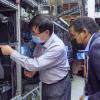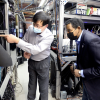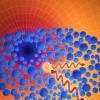Headlines
 Last month, U.S. Rep. Joe Neguse got a first-hand look at the future of ultrafast lasers, record-setting clocks and quantum computers when he toured facilities at JILA, a research partnership between CU Boulder and NIST. The visit comes as investments in quantum research are expanding across the country.
Last month, U.S. Rep. Joe Neguse got a first-hand look at the future of ultrafast lasers, record-setting clocks and quantum computers when he toured facilities at JILA, a research partnership between CU Boulder and NIST. The visit comes as investments in quantum research are expanding across the country. Congressman Joe Neguse, D-Lafayette, toured JILA on December 16 to talk about the Build Back Better Act. Founded in 1962, JILA is one of many research facilities feeling the impact of aging infrastructure. Funds from the House-passed bill would help equip the institute to more effectively chase world-changing ideas in physics through the next decade and beyond.
Congressman Joe Neguse, D-Lafayette, toured JILA on December 16 to talk about the Build Back Better Act. Founded in 1962, JILA is one of many research facilities feeling the impact of aging infrastructure. Funds from the House-passed bill would help equip the institute to more effectively chase world-changing ideas in physics through the next decade and beyond. Jun Ye (Physics), director of the CUbit Quantum Initiative, has received a number of recent awards and honors for his groundbreaking work in quantum science, including the 2022 Herbert-Walther Award, the Niels Bohr Institute Medal of Honor for 2021, and a 2021 Highly Cited Researcher award from Clarivate.
Jun Ye (Physics), director of the CUbit Quantum Initiative, has received a number of recent awards and honors for his groundbreaking work in quantum science, including the 2022 Herbert-Walther Award, the Niels Bohr Institute Medal of Honor for 2021, and a 2021 Highly Cited Researcher award from Clarivate. The business podcast "Innovating with Scott Amyx" recently interviewed ColdQuanta CEO Scott Faris about the process of commercializing the company's pioneering cold atom quantum technology, products and services—which grew out of research originally conducted at CU Boulder.
The business podcast "Innovating with Scott Amyx" recently interviewed ColdQuanta CEO Scott Faris about the process of commercializing the company's pioneering cold atom quantum technology, products and services—which grew out of research originally conducted at CU Boulder. “Quantum information technologies are at a tipping point in growing into a new economic pillar due to recent advances, federal funding and private investment," says CUbit Executive Director Philip Makotyn. “Inclusion and equity of is critical if we’re to meet the growing workforce and supply chain needs."
“Quantum information technologies are at a tipping point in growing into a new economic pillar due to recent advances, federal funding and private investment," says CUbit Executive Director Philip Makotyn. “Inclusion and equity of is critical if we’re to meet the growing workforce and supply chain needs." On a quantum level, how atoms and light interact has been a topic of interest for many years. In a new paper published in Science, JILA and NIST Fellow Jun Ye and his lab members report on how light scattering is affected by the quantum nature of the atoms—more specifically, the Pauli Exclusion Principle.
On a quantum level, how atoms and light interact has been a topic of interest for many years. In a new paper published in Science, JILA and NIST Fellow Jun Ye and his lab members report on how light scattering is affected by the quantum nature of the atoms—more specifically, the Pauli Exclusion Principle. The new $7.8M cleanroom will be in the Sustainability, Energy and Environment Laboratory (SEEL) building and is the 21st century machine shop that will enable a wide spectrum of research projects, in areas spanning from electronics, photonics and quantum science to environment, bio-medical and nanomedicine.
The new $7.8M cleanroom will be in the Sustainability, Energy and Environment Laboratory (SEEL) building and is the 21st century machine shop that will enable a wide spectrum of research projects, in areas spanning from electronics, photonics and quantum science to environment, bio-medical and nanomedicine. JILA Fellows Ana Maria Rey and James K. Thompson have published paper in Physical Review Letters that discusses a new protocol that could make entangled quantum interferometers easier to produce and use, improving gravitational acceleration measurements.
JILA Fellows Ana Maria Rey and James K. Thompson have published paper in Physical Review Letters that discusses a new protocol that could make entangled quantum interferometers easier to produce and use, improving gravitational acceleration measurements. Created by the Colorado Office of Economic Development and International Trade (OEDIT), the film interviews CUbit Director Jun Ye, Associate Research Professor Ana Maria Rey, Dan Caruso of university startup ColdQuanta, and other members of CU Boulder's quantum community about the importance of quantum research and Colorado's prominence in the field.
Created by the Colorado Office of Economic Development and International Trade (OEDIT), the film interviews CUbit Director Jun Ye, Associate Research Professor Ana Maria Rey, Dan Caruso of university startup ColdQuanta, and other members of CU Boulder's quantum community about the importance of quantum research and Colorado's prominence in the field. Created in 2021, the Quantum Engineering Initiative (QEI) is a significant and strategic investment into translational quantum engineering research at CU Boulder—including educational components, faculty hiring efforts, and dedicated lab space for collaboration with partners both on and off campus.
Created in 2021, the Quantum Engineering Initiative (QEI) is a significant and strategic investment into translational quantum engineering research at CU Boulder—including educational components, faculty hiring efforts, and dedicated lab space for collaboration with partners both on and off campus.

